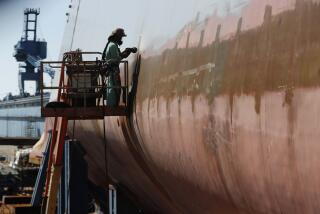McDonnell Revising Navy Jet Trainer : U.S. Cost-Cutting Effort Blamed for ‘Run-of-the-Mill’ Problems
McDonnell Douglas officials said Monday that they are working to fix more than a dozen technical deficiencies recently discovered on the T-45 Goshawk, a Navy trainer airplane under development at the firm’s Douglas Aircraft unit in Long Beach.
The Navy’s commander for operational test and evaluation said in a report last month that the thrust of the T-45’s Rolls-Royce Turbomeca jet engine is inadequate and that the aircraft also has flight control problems.
“The T-45 in its current configuration does not have the potential to be operationally effective in the (aircraft) carrier training environment,” the report to the chief of Naval operations said.
Douglas program manager H. Z. Hopkins characterized the problems as “run of the mill” and said the company’s engineering staff has come up with solutions to most of the problems already. “We’ll know more in a month,” he said.
Many of the problems are the direct result of efforts by former Navy Secretary John F. Lehman Jr. to force down the originally proposed development cost of the plane by nearly 50%, Hopkins said.
In an effort to cut costs, for example, Douglas did not conduct low-speed wind tunnel tests or computer simulation tests. The T-45 design is based on the British Hawk trainer, but there were substantial aerodynamic modifications--including changes in the location of the aircraft’s landing gear and speed brakes--that were never tested in a wind tunnel, Hopkins said.
The T-45 project was heralded by Lehman as a symbol of the sort of aggressive cost-cutting that could be accomplished with fixed-price development contracts. The policy that encouraged such contracts was repudiated, however, after a number of contractors experienced huge losses.
“Those guys--none of them are around any more,” Hopkins said about Lehman’s team that forced down the cost of the program. The company signed a $512-million, fixed-price development contract in 1985.
Focusing on Solutions
“It was a risky venture,” Hopkins said. “That’s one reason we had to go to the chairman of the corporation to get his approval.”
For the time being, Douglas and the Navy have agreed to set aside contractual issues about the cost of the fixes and focus on finding solutions to the problems. Hopkins said the Navy may have to bear the cost of at least one problem, involving the inadequate thrust of the engine.
The thrust of the T-45 engine is not sufficient to allow the aircraft to recover from aborted landings on aircraft carriers, which often occur when aircraft miss the arresting wires or when a wire breaks, according to the Navy report. In such a case, the plane must go to full power and attempt to fly off the short deck of the carrier.
That deficiency resulted from an agreement by Douglas and the Navy to “derate” the T-45’s Rolls-Royce engine from 5,700 pounds thrust to 5,450 pounds in an effort to increase engine life and reduce the maintenance costs.
Hopkins said the engine thrust can be increased by making a minor modification, but that will result in reduced engine life and higher operational cost. That cost, estimated to be in “the millions of dollars over a 20-year period,” is subject to negotiation since the Navy agreed to the original thrust reduction, he said.
In addition, the aircraft has a directional stability problem at low speed and can enter a stall without adequate warning to the student pilots who will be flying the aircraft. The aircraft is about 100 pounds over the weight specified in the contract, but Hopkins said the company believes that it will be able to reduce that by switching from metal to composites for some parts.
Flight testing of the aircraft has slipped six months behind schedule, but the company is hoping it can recover by fall of 1990 when production aircraft are supposed to enter service.
Douglas has produced two prototypes of the plane that are being tested and expects to deliver the first production aircraft in September. The Navy plans to buy 300 of the planes.
More to Read
Inside the business of entertainment
The Wide Shot brings you news, analysis and insights on everything from streaming wars to production — and what it all means for the future.
You may occasionally receive promotional content from the Los Angeles Times.










